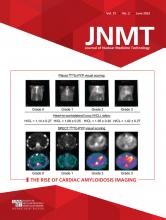Abstract
Phyllodes tumor (PT) represents a rare type of breast tumor arising from the stromal component rather than the epithelium. Metastatic spread occurs hematogenously, with lung, bone, brain, and liver being the most common sites. We present the 18F-FDG PET/CT scan of one such case of phyllodes tumor showing cardiac and pancreatic metastases, which are an extremely rare occurrence.
Phyllodes tumors (PT) are rare mesenchymal tumors arising from the connective tissue of the breast. They are relatively rare, accounting for approximately 0.3%–1% of all breast tumors (1). The World Health Organization classifies PTs into 3 categories (benign, borderline, and malignant) on the basis of histopathologic features including nuclear atypia, stromal cellularity, mitotic activity, tumor margin appearance, and stromal overgrowth (2). Malignant PTs constitute approximately 10%–15% of all cases but are aggressive, with rapid growth, and around 9%–27% of malignant histotypes harbor metastasis (2).
CASE REPORT
A 55-y-old woman presented with a painful, rapidly growing lump in the left breast. Bilateral x-ray mammography and ultrasonography of the breasts revealed a huge multilobulated radiodense BI-RADS (Breast Imaging Reporting and Data System) 4 lesion measuring 10.8 × 12.6 cm in the left breast. Tru-Cut (Merit Medical Systems) biopsy of the lesion was performed, and histopathologic examination revealed a benign PT. After this diagnosis, the lesion was excised and on final histopathology was found to be a malignant histotype with no tumor-free margins. The patient then underwent wide local excision of the residual mass. For metastatic workup, the patient underwent contrast-enhanced CT of the abdomen and pelvis and high-resolution CT of the chest, and no evidence of metastatic disease was found. However, 1 y later she presented with left axillary lymphadenopathy. Axillary node sampling and histopathologic examination confirmed metastasis from the PT. For disease evaluation, the patient was referred for PET/CT, which showed widespread metastasis involving the left lung, the head of the pancreas, and multiple skeletal sites, as well as a tumor thrombus in the left atrium (Fig. 1). Echocardiography confirmed the presence of a mass in the left atrium.
PET/CT images of patient diagnosed with malignant PT. (A) Maximum-intensity-projection image showing multiple foci of abnormal 18F-FDG uptake. (B and C) PET/CT image (B) and contrast-enhanced CT image (C) showing tumor thrombus (arrows) in left atrium. (D and E) PET/CT image (D) and contrast-enhanced CT image (E) showing 18F-FDG–avid hypodense lesion (arrowheads) in pancreatic head.
DISCUSSION
PT usually presents in as a breast lump in patients 35−55 y old. On examination, a PT is usually a large (>3 cm), mobile, and painless mass that is well defined, smooth, and multinodular. It may grow slowly, rapidly, or biphasically. Imaging studies can help in reaching the diagnosis and guiding the biopsy for confirmation of diagnosis (3).
On mammography, a PT typically appears as a smooth, polylobulated mass resembling fibroadenoma. On ultrasonography, a PT typically is solid, hypoechoic, and well circumscribed but sometimes has cystic areas. Breast lesions suspected of being PTs should undergo core-needle biopsy rather than fine-needle aspiration cytology, because of the high false-negative rate of latter. Once the diagnosis is made, CT or MRI is done to examine disease extent and resectability. When metastasis is suspected, PET/CT is ordered to look for distant spread of tumor (4).
Complete surgical excision with a tumor-free margin is the standard of care for PTs because of the high recurrence risk. Adjuvant radiotherapy can be considered. Localized disease has a good survival rate approaching as high as 80%–90% with surgical management with or without radiotherapy. However, for metastatic disease, the prognosis is dismal, with a mean survival of only 11 mo. Metastatic disease has been associated with a malignant histotype, a large tumor size (>5 cm), mitotic activity, positive surgical margins, the presence of necrosis, and a young age. PTs respond poorly to chemotherapy and hormonal therapy (5).
Metastatic spread occurs hematogenously, and the common sites for metastasis include lung (66%–84.5%), bone (28%–39%), and brain and liver (6). Rarely the metastasis spreads to other organs such as the adrenal gland, small intestine, kidney, pancreas, or pelvis (7). Cardiac metastasis is rare and usually seen as a part of multiorgan spread (4). Cardiac metastasis usually involves the right side of heart and is rarely seen in the left chambers (4).
Cardiac metastasis dictates reduced survival because of associated widespread disease and the risk of hemodynamic compromise and sudden cardiac death (8). Echocardiography can detect cardiac metastasis but usually underestimates its extent (9). Cardiac CT, cardiac MRI, and PET/CT can delineate the exact extent of cardiac metastasis (9). However, PET/CT can also differentiate tumor from thrombus and can serve as a 1-stop investigation of whole-body spread as in the present case, in which 18F-FDG PET/CT revealed extensive metastatic disease with involvement of both the pancreas and the left atrium—an extremely rare occurrence (8).
CONCLUSION
Metastasis in malignant PT most commonly involves the lung, skeleton, liver, and brain. Metastatic spread to other organs is rare. The presented 18F-FDG PET/CT scan of malignant PT showed metastasis to both the pancreas and the left atrium—an extremely rare occurrence.
DISCLOSURE
No potential conflict of interest relevant to this article was reported.
Footnotes
Published online Feb. 7, 2023.
REFERENCES
- Received for publication November 17, 2022.
- Revision received January 26, 2023.








